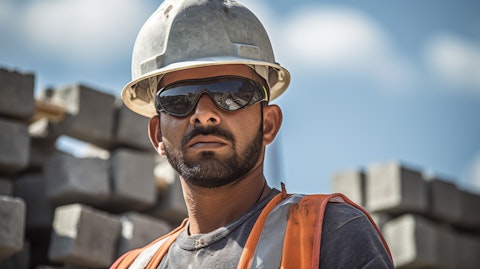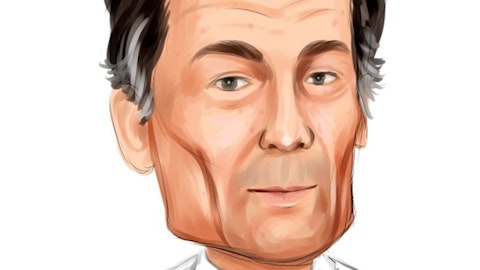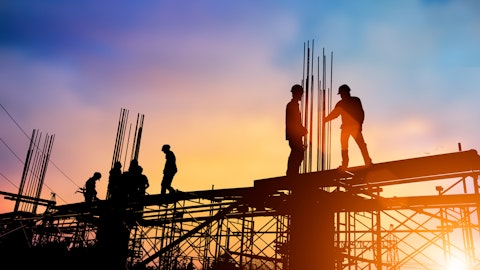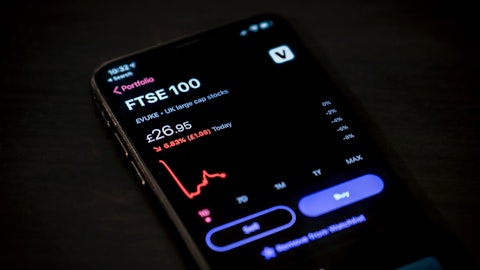CRH plc (NYSE:CRH) Q3 2023 Earnings Call Transcript November 21, 2023
Operator: Good day. My name is [Mandeep], and I will be your conference operator today. At this time, I’d like to welcome everyone to the CRH Earnings Update Conference Call [Operator Instructions]. I will now hand the call over to Albert Manifold, CRH Chief Executive to begin the conference.
Albert Manifold: Hello, everyone. Albert Manifold here, CRH Group Chief Executive and you’re all very welcome to our conference call and webcast presentation, which accompanies the release of our earnings update earlier today. Joining me on the call is Jim Mintern, our Group CFO; and Tom Holmes, Head of Investor Relations. Over the next 20 minutes or so, Jim and I will take you through some of the main points of this morning’s announcement, highlighting the key drivers of our trade performance for the first nine months of the year, providing you with an update on recent portfolio activity as well as an indication of our expectations for the year as a whole. Based on the visibility that we have at this moment in time, we’ll also share our thoughts on some trends we’re seeing across our markets as we look ahead to 2024.
Afterwards, we’ll be available to take any questions that you may have. And all told, we should be done in 45 minutes or so. First, on Slide 1. I’d like to take a moment to mention a few of the key highlights from this morning’s statement. Following overwhelming support from our shareholders earlier this year, we successfully completed the transition of our primary listing to the New York Stock Exchange in September. This is an important milestone in our development and one that will enable CRHto fully participate in the significant growth opportunities that lie ahead. With regard to trading performance, I’m pleased to report that the positive momentum we experienced in the first half has continued into the third quarter. And for the first nine months of the year, our business has delivered further growth in sales, EBITDA and margin.
Total group sales of $26.3 billion were 8% ahead, reflecting good underlying demand and further commercial progress across our businesses. This translates into EBITDA of $4.8 billion, 14% ahead and a further 100 basis points of margin improvement, a strong performance despite [containing] but some inflationary cost pressures. This morning, we’ve announced an agreement to acquire an attractive portfolio cement and readymix concrete assets in Texas for $2.1 billion, a significant investment which will deliver further growth and value creation for our shareholders. I’ll take you through that in further a little later presentation. We also continue to return significant amounts of cash to our shareholders through dividends and share buybacks. Our ongoing share buyback program is on track to return approximately $3 billion in 2023 and the current tranche of the program will be completed before the end of the year.
In advance of our intented transition to quarterly dividends in 2024 and consistent with our progressive dividend policy and strong financial position, this morning, we have announced an accelerated payment of our 2023 dividend, representing a 5% increase compared to the prior year. Looking ahead to the remainder of the year and based on current trading conditions at the momentum we see across our businesses, I’m pleased to report that we are raising our previous guidance and expect to deliver full year group EBITDA of approximately $6.3 billion well ahead of the prior year and representing another record year for CRH. Turning to Slide 2 and before taking you through the trading performance for each of our businesses, I’ll briefly outline our thoughts on the market backdrop and trading environment across our main markets of North America and Europe over the course of the year so far.
Despite the impact of higher interest rate environment, we continue to experience positive underlying demand across our key end use markets. In infrastructure, our largest end market representing approximately 40% of revenues, it continues to be underpinned by historic increases in US federal, state and EU funding programs. In non-residential, we continue to experience good demand in our key segments, particularly in new-build manufacturing and industrial facilities. These are typically large complex projects, which fit very well with our capability to deliver fully integrated bespoke solutions to our customers. As for residential, while the pace of new-build construction in North America and Europe continues to be impacted by higher interest rates and affordability constraints, remodeling demand remains resilient, supported by high home equity values and an aging housing stock in growing need of repair, maintenance and [improvement].
Turning now to the trading performance of each of our businesses and first to the Americas Materials Solutions on Slide 3, which delivered strong performance through the first nine months of the year. Notwithstanding some challenging weather conditions impacting our operations in certain regions of the United States, total sales and EBITDA were 7% and 11% ahead of the prior year respectively. And despite contending with some inflationary cost pressures, particularly in the areas of raw materials, labor and logistics, I’m pleased to report further improvement in our margin, 70 basis points ahead reflecting good commercial management across all product lines and disciplined cost control. As we look out to the remainder of the year, I’m also encouraged by the positive momentum in our backlogs, which we’re now seeing the benefits in the historic uplift in US infrastructure spending, I mentioned earlier.
So overall, another strong performance from Americas Materials Solutions, which continues to be underpinned by the benefits of our integrated strategy. Next to America’s Building Solutions on Slide 4, which has also delivered strong profit growth and further margin expansion in the first nine months of the year. Our Building & Infrastructure Solutions business continues to benefit from a positive moment in our key markets, underpinned by significant public investment in water, energy, utility infrastructure and increased levels of onshoring activity in the manufacturing sector. Our Outdoor Living Solutions business also continues to perform well, supported by resilient residential [online] demand from both retail and professional customers, good pricing momentum and the contribution from Barrette Outdoor Living, which we acquired last year.
So for Americas Building Solutions overall, total sales growth of 15% translated into a 23% increase in EBITDA, reflecting good operating leverage and a further 150 basis points of margin improvement. Moving across to Europe on Slide 5, at first to the performance of our Europe Materials Solutions business. Nine-month sales were 6% ahead of the prior year period with positive pricing momentum more than offsetting subdued residential demand. This translates into 20% EBITDA growth and a further 180 basis points of margin improvement, reflecting strong operating leverage and our continued focus on commercial discipline, operational excellence initiatives and cost saving and actions to mitigate the impact of inflation. We’re now in our sixth consecutive year of positive pricing momentum in Europe.
We’re pricing ahead across all products during the first nine months of the year. Looking ahead to the remainder of 2023 and into next year, we’re focused on maintaining strong commercial discipline to protect and improve our profitability. Next to the performance of Europe Building Solutions on Slide 6. Overall, a more challenging trading environment, impacted by subdued residential activity and compounded by extended winter weather conditions across our markets earlier in the year. However, activity levels in the non-residential and infrastructure segments remain resilient, supported by good levels of public funding. We continue to focus on good commercial management and cost savings actions to mitigate the impact of lower activity levels and we expect trading trends to improve into 2024.
At this point, I’m going to hand over to Jim to take you through the year end balance sheet expectations and our transition to quarterly dividends next year.

Jim Mintern: Thanks, Albert, and good morning, everyone. Turning now to Slide 7. And here, you can see the key components underpinning our expectations for our year end net debt position. I’m pleased to report that we expect to end the year with one of the strongest balance sheets in our history, reflecting our relentless focus on disciplined capital allocation and continuous business improvement to deliver higher profits, margins, returns and cash for our shareholders. Let me briefly take you through the key components working from left to right on the slide. We ended 2022 with a net debt position of $5.1 billion, representing a net debt to EBITDA of just under 1 times. We expect 2023 to be another year of strong cash generation for the group, enabling us to continue to invest for further growth while also returning significant amounts of cash to our shareholders through dividends and share buybacks.
In the year-to-date, we’ve invested approximately $700 million on 16 strategic bolt-on acquisitions, further developing our solutions capabilities and road infrastructure, utility infrastructure and outdoor living. We also expect to invest approximately $1.8 billion in capital expenditure in 2023 to support further growth in our existing businesses. In addition, we expect to return approximately $4 billion to our shareholders through dividends and share buybacks. Our ongoing share buyback program is expected to return approximately $3 billion for the year. The current tranche of our program will be completed no later than the 20th of December, and we will update the market regarding our plans for further buybacks in due course. So taking all of this into account and assuming no further material development activity for the remainder of 2023, we expect to finish the year with net debt of approximately $7 billion or approximately 1.1 times net debt to EBITDA based on our full year EBITDA guidance.
Turning now to Slide 8 and this morning, we also announced that we intend to transition to quarterly dividends with more equally distributable payments commencing from the first quarter of 2024. This follows the successful change of our primary listing to the New York Stock Exchange in September and aligns with our transition to quarterly reporting of the US GAAP next year. In advance of our transition to quarterly dividends, the Board has decided to accelerate the payment of the 2023 dividend by distributing a second interim dividend of $1.08 per ordinary share. The second interim dividend payment will be in lieu of a final dividend, resulting in a full year dividend per share of $1.33 for 2023, which represents a 5% increase compared to the prior year.
We have a long and proud track record of progressive dividends and the increase in our full year dividend that we are declaring today represents CRH’s 40th consecutive year of dividend growth and stability.
Albert Manifold: Thanks, Jim. Turning now to Slide 9, and our agreement to acquire an attractive portfolio of cement and readymix concrete assets in Texas, a significant investment that will further strengthen our position as the number one building materials business in the fastest growing states in the United States. The assets are primarily located in the high growth markets of San Antonio and Austin, two of the fastest growing cities in Texas and will really complement our existing network of business across the Central Texas region. As you can see from the map on the right hand side of the slide, the acquisition is an excellent strategic fit with our existing materials and products operations in Texas. And by leveraging our expertise and technical capabilities from our wider North American cement platform, as well as our European Materials Business, it will result in significant synergies and self supply opportunities.
We have a proven capability and track record in that regard, demonstrated by the performance of Ash Grove since we acquired it in 2018. Whilst Texas is a highly attractive market from a construction standpoint, strong population and GDP growth continues to drive new build activity and is also the largest recipient of federal highway funding. As a result, the demand outlook is robust underpinned by a strong pipeline of large multiyear infrastructure and nonresidential projects. Next to Slide 10, where you can see the total [agreed] consideration of $2.1 billion. The combined portfolio of assets is expected to generate pro forma 2023 EBITDA of approximately $170 million, representing an attractive valuation before the significant synergies and savings we have identified to date.
The assets comprise a 2.1 million tonne cement plant together with the network of terminals along the Eastern Gulf Coast of Texas, as well as portfolio of 20 readymix [concrete] plants with annual shipments of approximately 1.6 million cubic yards. These are modern, high quality assets with an attractive return profile under our ownership, and the transaction will be initially margin accretive to the group. And perhaps most exciting role is the potential to unlock additional further growth and development opportunities in this attractive growth market. At $2.1 billion, this is our third largest ever deal and by integrating it into CRH, we believe we created tremendous amount of value for our business and our shareholders. We expect the acquisition to complete in the first half of 2024 and we’ll update you on that in due course.
Turning now to our outlook for the remainder of the year on Slide 11. Based on current trading conditions and the momentum we see across our businesses, I am pleased to report that we are raising our previous guidance and expect to deliver full year group EBITDA of approximately $6.3 billion, representing our tenth consecutive year of margin expansion and another record year for CRH. In addition, as a result of our ongoing focus on strong cash generation and balance sheet discipline, we expect to deliver approximately $5 billion of operating cash flow and the year end net debt-to-EBITDA ratio of around 1.1 times. Now before I hand over to Q&A, I’d like to take a moment on Slide 12 to share our thoughts on some of the trends we’re seeing across our major markets as we look ahead to 2024.
Today, North America represents 75% of group EBITDA and the remaining 25% in Europe. First to infrastructure, which represent the large exposure for the group. Here the outlook is robust. The demand in the United States underpinned by the continued rollout of once-in-a-generation federal and state investment program. Similarly in Europe, we expect robust demand in infrastructure activity to continue, supported by significant investment from government and EU funding programs. In non-residential, we expect key segments to continue to benefit from increased reindustrialization and onshoring activity. In the United States, this is supported by $650 billion of federal funding for increased investment in clean energy, [critical] utilities and high tech manufacturing following the passing of the Inflation Reduction Act and CHIPS and Science Act.
Europe is also benefiting from increased onshoring activity to over $200 billion of high tech manufacturing projects in the pipeline. In the residential segment, we expect new-build activity in the United States and Europe to remain subdued due to affordability changes caused by the current interest rate environment. This is not a demand issue and we believe the long term fundamentals for residential construction remain very attractive in these parts, supported by favorable demographics and significant levels of [underbuild]. So in summary, the overall trend is positive for our business heading into next year, supported by robust demand, infrastructure and key nonresidential segments, partly offset by subdued activity in new-build residential construction.
Regarding the pricing environment, we expect positive momentum to continue across our markets, supported by disciplined commercial management as well as the benefits of our integrated and value based solution strategy. So that concludes our presentation today, and we’re now happy to take your questions. May I ask to please state your name and the institution that you represent before posing your questions. In consideration for others in the line the to make the best use of time we have available I’ll ask you please limit your questions to one each where possible. I’ll now hand you back to the moderator to coordinate the Q&A session of our call.
See also 12 Asian Countries With The Best Education System and 17 Countries With The Best Education In Europe.
Q&A Session
Follow C R H Plc (NYSE:CRH)
Follow C R H Plc (NYSE:CRH)
Operator: [Operator Instructions] Our first question comes from the line of Ross Harvey with Davy.
Ross Harvey: It’d be great to start with the acquisition in Texas, please. I’m just wondering, can you talk us through the rationale and your view on the macro backdrop in Texas and maybe also the synergy potential from the deal? Separately, we’re seeing support of growth trends in the US into 2024. Just wondering, can you talk us through how you see CRH is positioned to capitalize on those?
Albert Manifold: Let me address your first question with regard to the deal we announced this morning, the signing of the deal with the acquisition of the cement plant and readymix concrete assets in Texas. I mean, Texas is the number one construction state in the United States, second most popular state and actually one of the fastest growing states in the US. And we have been the largest building materials player in Texas for quite some time and it makes sense for us given the growth dynamics going there were population growth, [immigrant] migration, it’s the beneficiary of a lot of onshoring activity and in fact, Texas has more roads than any other state in the United States. And in fact, it’s got 50% more roads than Sierra, California, which is number two.
A little bit of broad spectrum of the businesses that we’re involved in, the processing of basic raw materials, how we turn those basic raw materials into different products, good there for roads or for general construction or for complex solutions, it absolutely is right in a sweet spot in terms of the high grade construction that’s going forward here, it fits with our solutions. So I look at all the dynamics going forward, looking at strong growth, it’s the largest recipient of highway funding and is part of the federal funding that’s currently in place. So everything point towards a good consistent strong growth, which is that — and as a number one player, we’re doubling down in our position there, and I will keep doubling down our position there because just putting ourselves into good markets like this where we have an opportunity to excel and being number one matters in our industry, because it gives you scale and scale gives you cost advantages, gives you market advantages and allows you to access more of your customers wallet.
So that’s why Texas quite simply. And with regards to the cycle, well, look, I mean, I think we’re in a strong growth cycle across the United States at this moment in time. 70% of our sales go into either infrastructure or commercial construction. And if you look at where that has been driven at this moment of time, obviously, infrastructure has been driven by the various stimulus packages and the robust state budgets. But on top of that, we’re seeing very significant growth coming from the onshoring and reshoring of commercial activities. And I think that alone is going to drive things. For sure, residential is in at a low point. But given where we’ve seen inflation fall back during this year happening. So we expect to see an easing of the interest rate environment, and that will address some of the affordability issue, and we expect towards the end of 2024 to residential coming back online.
So I think we’re in a good place in the cycle and actually, quite frankly, in Texas, we’re in a good place to be there in that position cycle. It’s too early to quantify synergies yet, hardly perfectly — you would expect as one of the most experienced and capable cement producers in the world with cement factories all across Europe and all across the United States, and we have a lot of expertise and a lot of experience. All I will do is point you back to this telephone call in 2018 when we acquired Ash Grove and we bought that business, we were delighted to buy it. And in the five years, we doubled the profitability of Ash Grove over the last five years, we did that by our process technology, our skill and our expertise, reducing different types of fuels, different types of cements, and that’s exactly what we were planning to do with this particular cement plant and across our — and continue to do so across our other cement plants.
And when we get our feet on the table in next year, we’ll come back and we’ll be more specific with our plans and the timing of those synergies. Your second question was generally about sort of growth trends across the US in 2024 and how do we view where our position is. Look, we are the largest building materials business in the United States. We’re the largest aggregate producer in the United States. We’re the clear number one in the growth states of Texas and Florida, two of the top three states in the United States. In fact, three of the top four states, CRH is number one in Texas, Florida and New York. We’re a top three cement producers. So we position ourselves to be a manufacturer producer of high quality solutions in the fastest growing regions of the United States.
And as I’ve said to you, we are a major beneficiary of infrastructure [stimulus] packages, it’s about 50% of what we do. And that looks like it’s going to continue for several years going forward. On top of that, we’re uniquely positioned to capitalize on the onshoring activity we’re seeing. Our solutions strategy is playing out very well and it manifests itself in the leverage we’re seeing coming through at the bottom line, the increased margin you’re seeing within the business and crucially, the increased cash we’re generating. So we’re generating higher profits, cash and returns than anybody else. As I keep saying about CRH, if you add up our next four peers together, there’s still less than CRH on its own, that’s the size and scale of CRH.





